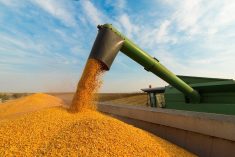Reuters — U.S. soybean futures retreated on Friday from a one-month high, pressured by a dip in crude oil prices and a round of farmer selling while market players awaited upcoming U.S. trade talks with China, the world’s top soybean buyer.
Corn futures fell as the Midwest harvest advanced and wheat drifted lower.
Chicago Board of Trade November soybean futures were down three cents at $10.41-3/4 per bushel, turning lower after a climb to $10.45-1/2, the contract’s highest since Sept. 19.
December corn was down 4-3/4 cents at $4.23-1/4 per bushel, easing back from a one-month high set on Thursday, and December wheat was down half a cent at $5.12-1/2 a bushel.
Soybeans and corn came under pressure as rallies this week triggered a round of grain sales by producers, analysts said.
“There was a fair amount of cash grain that moved yesterday, so we are seeing some pressure on spreads because of the cash movement. The farmer stepped up and sold a fair amount of grain,” said Dan Basse, president of Chicago-based AgResource Co.
Otherwise, trade was subdued as market players awaited news on U.S. trade relations with China, which has shunned U.S. soybeans so far this marketing year in favor of South American supplies.
U.S. President Donald Trump is set to meet next week with Chinese President Xi Jinping in South Korea, with Trump reiterating that soybean purchases will be a major point of discussion.
Top economic officials from the U.S. and China were due to arrive in Malaysia on Friday for talks to prevent a trade war escalation and keep next week’s meeting between Trump and Xi on track. U.S. Treasury Secretary Scott Bessent and U.S. Trade Representative Jamieson Greer will meet with Chinese Vice Premier He Lifeng to find a way forward.
A trade deal could help U.S. farmers avert steep losses, but the window for fresh purchases is narrowing.
“If a deal is reached in early November, China could secure shipments for the second half of December or January. Beyond February, however, Brazil’s new crop will enter the market,” said Ishan Bhanu, lead agricultural commodities analyst at Kpler.
— Reporting by Julie Ingwersen; additional reporting by Ella Cao, Lewis Jackson and Sybille de La Hamaide














